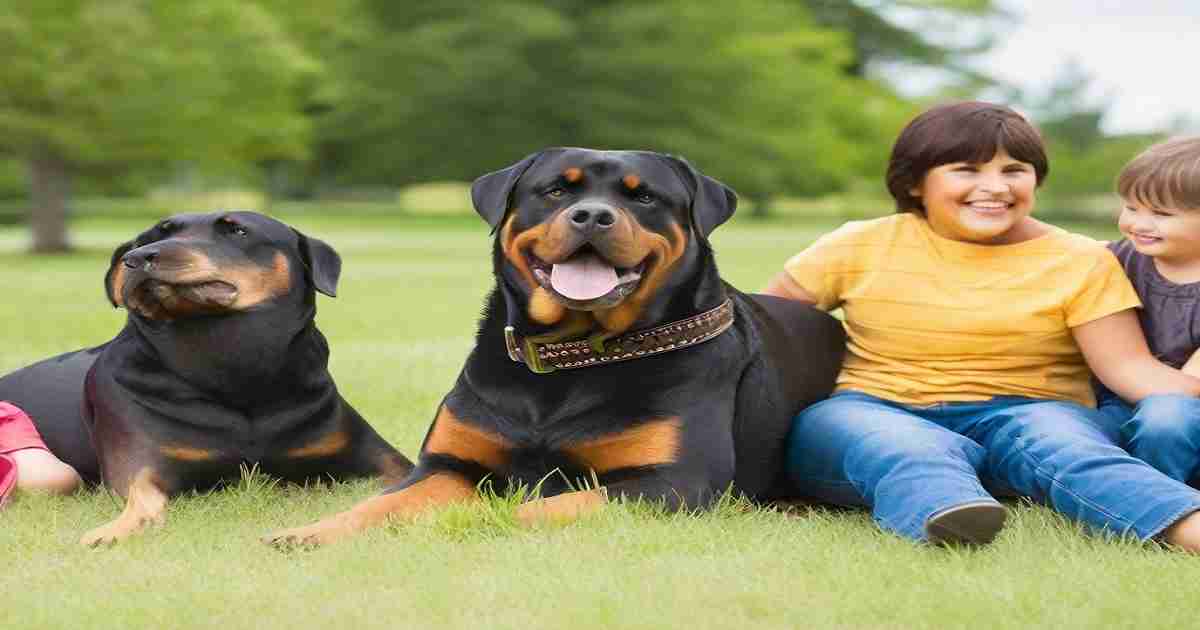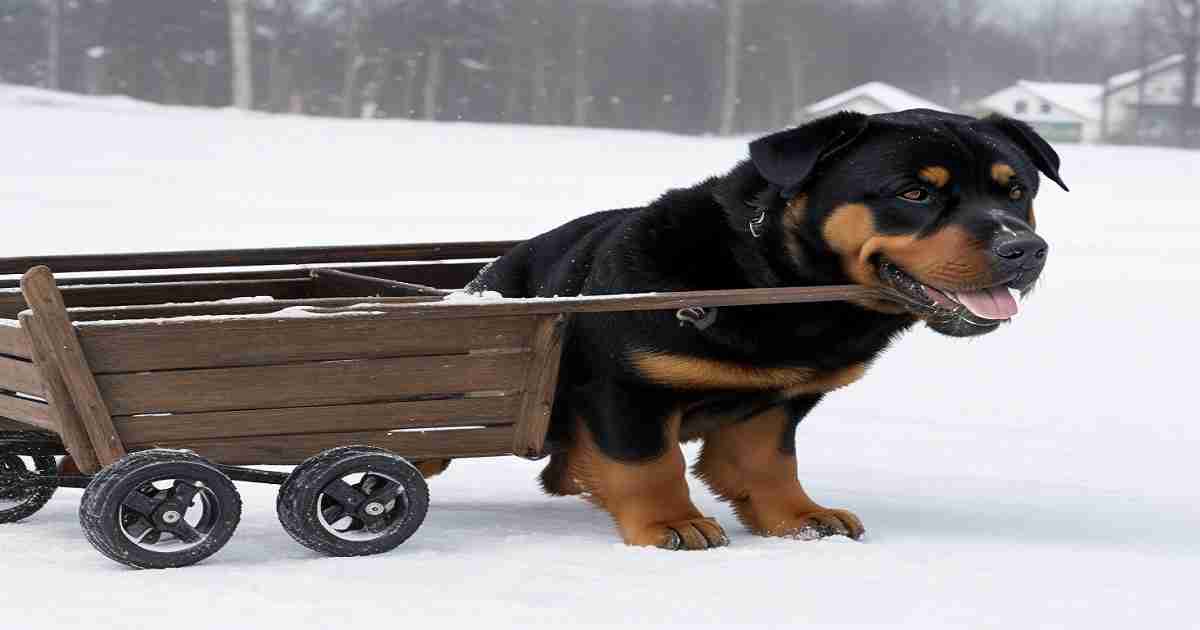You fell in love with the noble, protective nature of the Rottweiler breed. Now comes the big decision – German or American variety? At first glance, they may look similar, but there’s a sizable difference you can’t ignore.
Making the correct choice requires understanding what that size gap means for feeding, exercise, training, and lifestyle. Don’t worry. We’ve got you covered.
This guide will highlight the critical size differences between German and American Rottweilers so you can pick the perfect fit for your home and family. Let’s dive in and make the most of this size showdown!
A Brief History of the Two Varieties
The Rottweiler originated as a rugged, powerful herding and guard dog in the small German town of Rottweil. Their strength, intelligence, and protective instincts made them invaluable workers.
When Rottweilers came to North America in the 1920s, breeders developed a slightly smaller version more suited for show rings and urban living. It gave rise to the American Rottweiler.
Meanwhile, German breeders maintained the more significant, traditional working standard. So, while technically the same breed, the two varieties diverged in size.
Today, German Rottweilers hearken back to the breed’s working roots. American Rottweilers reflect efforts to adapt the dogs to modern city or suburban lifestyles.
Key Size Differences Between the Varieties
The size difference between German and American Rottweilers stems from contrasting breeding goals.
On average, German Rottweilers are:
- Males: 24-27 inches tall (61-69 cm), 95-135 pounds (43-61 kg)
- Females: 22-25 inches tall (56-63 cm), 80-115 pounds (36-52 kg)
American Rottweilers tend to be:
- Males: 22-25 inches tall (56-63 cm), 75-105 pounds (34-48 kg)
- Females: 20-23 inches tall (51-58 cm), 60-90 pounds (27-41 kg)
The varieties differ between 2-5 inches and 20-50 pounds. German Rottweilers are the larger, more substantial build.
Several factors influence these German Rottweiler Vs American Rottweiler size ranges, including:
- Genetics: German dogs bred toward larger size for work. American dogs are selected for shorter stature.
- Diet: The higher calorie needs of active German Rottweilers promote growth.
- Exercise: German Rottweilers require more exercise, which supports lean muscle development.
- Geographic location: German dogs bred in mountainous areas may be slightly larger.
While genetics determine the potential size, proper nutrition, activity levels, and environmental conditions help a Rottweiler reach the full size his genes allow.
Implications of the German Rottweiler Vs American Rottweiler Size Difference
This considerable size gap between German and American Rottweilers has meaningful implications for lifestyle and care. Let’s explore them.
Activity Levels
The larger German Rottweiler needs more exercise to stay fit and stimulated. Without sufficient activity, these powerful dogs can become bored and destructive.
Plan on providing a German Rottweiler with:
- 60+ minutes of vigorous exercise daily, such as running, hiking, and swimming.
- Mental stimulation through training, puzzles, and interaction.
- A large yard for play and potty breaks. German Rottweilers adapt better to rural or suburban homes.
The American Rottweiler, while still energetic, has lower exercise requirements. About 30-60 minutes of daily activity plus yard access keeps them fit and calm.
Their moderate size suits them well for urban living, houses with modest yards, or apartments. American Rottweilers can thrive with less space than their German counterparts.
Feeding Requirements
The bigger size of German Rottweilers commands a higher calorie intake to maintain a healthy weight and fuel all that exercise. They eat around 4-6 cups of quality dog food daily.
American Rottweilers need 2-4 cups daily to meet their energy needs. They don’t require as many calories for essential functions and daily activities.
When calculating exact food amounts, consider your dog’s age, build, metabolism, and activity level. An active, working German Rottweiler needs more calories than a couch potato who takes short walks.
Strength and Endurance
The German Rottweiler’s larger muscles and body weight make them better suited for strength activities like carting, sledding, and weight pulls. Their endurance also edges out the American variety.
American Rottweilers are lighter on their feet and excel at agility training, obedience trials, and companion events. Their moderate size gives them an advantage in these types of activities.
So, suppose you want a Rottweiler for competitive dog sports. In that case, the German dog’s power or the American’s agility may guide your choice.
Intimidation Factor
Given its roots as a guardian and working breed, the Rottweiler has a naturally protective temperament. Their large and robust build can intimidate people, for better or worse.
Some see the German Rottweiler as a benefit for properties wanting extra security. But public perception of this variety as more aggressive or threatening also increases.
The American Rottweiler’s diminutive stature makes them seem more approachable and less risky to insurers or landlords. But both varieties have the same devoted, calm, yet courageous temperament when adequately socialized and trained.
If size-related discrimination concerns your area, the American Rottweiler may draw less negative attention.
Choosing the Right Rottweiler Variety for You
Now that you understand the critical differences between the German and American Rottweiler, it’s time to pick the perfect match for your lifestyle. Consider the following:
Your Activity Level
- An active home that hikes, runs, and spends time outdoors suits the high-energy German Rottweiler.
- The lower-maintenance American Rottweiler fits better for passive owners who prefer short walks and couch cuddles.
Your Home Environment
- The German Rottweiler does best with a large yard or acreage and nearby parks.
- The American Rottweiler readily adapts to smaller urban homes or apartments.
Your Experience
- First-time owners may find the American Rottweiler easier to handle and train.
- Experienced dog owners are better equipped for the German Rottweiler’s greater size, energy, and headstrong nature.
Your Training Abilities
- The German Rottweiler needs an owner to provide firm, consistent obedience training.
- Pet owners looking for a more easy-going companion may prefer the American Rottweiler.
Your Family Situation
- The American Rottweiler generally does better in homes with small children.
- German Rottweilers can thrive in homes with older kids able to interact appropriately with large dogs.
Consider your lifestyle and abilities before deciding which variety suits them better. Raising and training these powerful, intelligent dogs is truly a commitment.
Caring for a Rottweiler Puppy
Whether you choose German or American, proper care from puppyhood ensures a healthy, well-adjusted dog. Here are tips:
Nutrition
Feed a high-quality puppy food formulated for large breeds. The proper nutrition supports bone growth and avoids overfeeding.
Supplement with glucosamine, chondroitin, and fish oil for joint health. Provide chew toys to relieve teething. Avoid calcium supplements that accelerate growth.
Exercise
Limit exercise to short, gentle walks until 12-18 months old. No running, jumping, or rough play that stresses joints. Controlled off-leash play in a fenced area is beneficial.
Socialization
Socialize your Rottweiler puppy to new places, people, animals, and experiences calmly and positively. Well-socialized pups are friendly and confident.
Training
Start training in basic obedience early. Use reward-based techniques, but be firm. Nip problem behaviors in the bud. Establish yourself as a consistent pack leader.
Medical Care
Keep up with vaccines and veterinary checkups. Spay/neuter at 12-24 months once growth plates close. Microchip your puppy for identification.
Follow these best practices during the crucial first year. Reap the rewards of having a stellar adult Rottweiler for years to come.
Common Health Issues in Rottweilers
All dogs have specific health risks associated with their breed. For Rottweilers, watch out for:
Hip and Elbow Dysplasia
This painful degenerative joint disease results from the abnormal formation of hip and elbow joints. It’s common in large breeds. Maintaining lean body weight and avoiding exercise on slippery floors helps prevent it. X-ray breeding dogs and don’t breed affected animals.
Gastric Dilatation Volvulus (GDV) or Bloat
The risk of this life-threatening twisting of the stomach impacts all Rottweilers. Prevent bloat by avoiding vigorous exercise for 1 hour before and after eating. Split meals into multiple smaller portions. Slow down fast eaters with puzzle bowls. Learn the signs of bloat, which requires emergency surgery.
Heart Conditions
The most common heart diseases seen in Rottweilers are congenital subaortic stenosis (SAS) and dilated cardiomyopathy (DCM). Have a veterinary cardiologist evaluate breeding dogs. Discuss screening tests with your vet.
Discuss these genetic issues with your breeder and ask about their health testing protocols. Then, keep up with preventative care and veterinary checkups to ensure your Rottie lives their healthiest, most extended life.
Frequently Asked Questions
Do you still need some help deciding between German and American Rottweilers? Here are answers to some common questions.
What causes the size difference between the two varieties?
Selective breeding is why German Rottweilers maintained larger while American lines became smaller. German breeders prioritized the breed’s working capabilities. Americans wanted easier-to-manage show dogs and pets, so they chose shorter stature.
At what age do Rottweilers reach their full size?
Rottweilers keep growing until 12-24 months old. The bulk of their height comes in 9 months, then they fill out and add muscle mass. Make sure to limit diet and exercise to avoid stressing developing joints.
How much should I feed my Rottweiler puppy?
On average, a Rottweiler puppy eats 2-4 cups of food spread into 3-4 meals. More extensive German lines may eat up to 6 cups daily by 9-12 months old. Follow your chosen food’s feeding guidelines based on projected adult weight. Adjust amounts based on your puppy’s ideal weight and body condition.
Is a German or American Rottweiler better with small kids?
With proper training and socialization, both varieties do well with kids. The American Rottweiler’s smaller size makes it easier for them to knock over toddlers by accident. Supervise all interactions and teach children how to act around dogs.
Are German Rottweilers more aggressive or dangerous dogs?
Not! When bred responsibly and raised with proper care, management, and training, a German Rottweiler has the same loyal temperament as the American variety. Their larger size simply makes people more wary. But it’s not justified by behavioral differences between the two.
Is it better to get a male or female Rottweiler?
The main differences are that males grow significantly more extensively and may be more territorial. Females tend to be more independent thinkers. For first-time owners, a female is the safer choice. But dogs are individuals, so focus less on gender and more on temperament when selecting your pup.
How can I make sure my Rottweiler grows into a healthy adult?
Pick from health-tested parents free of genetic issues. Use slow-growth formulas to avoid bone and joint problems. Feed a high-quality diet appropriate for their life stage. Vet-check pup regularly and stay up-to-date on preventative care. Limit exercise while young to prevent injury. Focus training on positive behaviors. With this care, you’ll set your Rottweiler up for lifelong health.
Ready to Find Your Perfect Rottweiler?
Deciding between German and American Rottweilers means understanding how their size difference impacts activity needs, training, temperament perceptions, and lifestyle.
While their origins may differ, today’s responsible breeders aim to produce dogs of sound health and temperament in line with the ideal Rottweiler – noble, intelligent, protective, and devoted.
Match yourself and your family with the variety best suited to your home, experience level, and daily life. Then, commit fully to providing the training, exercise, and care this remarkable breed needs to thrive.
Suppose you choose wisely and put in the work of responsible pet parenting. In that case, you’ll find your perfect companion, a stately German or adaptable American Rottweiler, joining your home.










1 thought on “How To Make The Most Of The German Rottweiler Vs American Rottweiler Size Showdown”